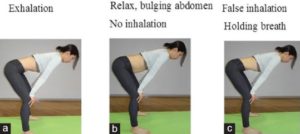Improve Physical and Respiratory Function with Yoga
By John M. de Castro, Ph.D.
“Respiration is our primary and most important movement pattern … and also the most dysfunctional.” – Karel Lewit
Breathing is essential for life and generally occurs automatically. It’s easy to take for granted as it’s been there our entire lives. Nevertheless, we become more aware of it when it varies with circumstances, such as when we exercise and also in emotional states, especially fear and anxiety. But we rarely notice it during everyday ongoing life. Yet, its characteristics are associated with our state of well-being. Slow deep breathing is characteristic of a healthy relaxed state. Breathing exercises are common in yoga practices and have been found to have a number of beneficial effects.
Yoga practice contains a number of different components that are mixed in varying combinations in different yoga practices. They consist of postures, meditation, relaxation, breathing exercises, and chanting. This presents a challenge in interpreting the beneficial effects of yoga practice. It is difficult to determine which component or which combination of components is required for the benefits.
In today’s Research News article “Positive Effects of Yoga on Physical and Respiratory Functions in Healthy Inactive Middle-Aged People.” (See summary below or view the full text of the study at: https://www.ncbi.nlm.nih.gov/pmc/articles/PMC6329219/ ), and colleagues examine the effects of yogic postures and the added benefits of yogic breathing in improving respiratory function in healthy inactive middle-aged people. They recruited inactive non-smoking adults aged 40 to 60 years who were not yoga practitioners and randomly assigned them to receive either training in yoga postures or training in yoga postures plus yogic breathing training. Training occurred in a 70-minute session once a week for 8 weeks. Participants were also provided a DVD for a 7-minute home exercises twice a week. They were measured before and after training for body size and composition, muscle endurance, resting heart rate, flexibility, respiratory function, and respiratory muscle strength.
They found both groups after training had significant improvements in muscle endurance, resting heart rate, and upper extremity flexibility. But only the group that had additional breathing exercises had significant improvements in lower extremity flexibility. Both groups had significant improvements in overall pulmonary function, including vital capacity, forced vital capacity, forced expiratory volume, and peak expiratory flow rate. But only the group that had additional breathing exercises had significant improvements in respiratory muscle strength and maximum inspiratory pressure.
The results demonstrated that yoga practice produces improvements in strength and flexibility and in respiratory function. But, adding breathing exercises produces additional benefits in flexibility and respiratory function. The study did not include a control group that performed a different exercise with equivalent intensity. So, it can’t be determined whether the physical improvements were specific to yoga or would have occurred with any equivalent exercise. But they do suggest that practicing yoga has physical benefits for strength, flexibility, and respiratory function, and including yogic breathing exercises helps to maximize the effectiveness of the yoga practice.
So, improve physical and respiratory function with yoga.
“yoga breathing: pranayama. It’s the art of breathing. Taking breathing to the next level. Learning different breathing techniques can add more beneficial oxygen to our bodies, aid in digestion, hone our concentration skills, calm our nerves, and much more.” – Gaiam
CMCS – Center for Mindfulness and Contemplative Studies
This and other Contemplative Studies posts are also available on Google+ https://plus.google.com/106784388191201299496/posts Yamamoto-Morimoto and on Twitter @MindfulResearch
Study Summary
Yamamoto-Morimoto, K., Horibe, S., Takao, R., & Anami, K. (2019). Positive Effects of Yoga on Physical and Respiratory Functions in Healthy Inactive Middle-Aged People. International journal of yoga, 12(1), 62-67.
Abstract
Context:
Yoga improves physical and respiratory functions in healthy inactive middle-aged people.
Aim:
This study aimed to assess the effects of 8 weeks of asana and asana with pranayama lessons in order to clarify the influence of two different combinations of yoga practice on physical and respiratory functions in healthy inactive middle-aged people.
Subjects and Methods:
A total of 28 participants (mean age: 52.7 years) were divided into a yoga asana (YA) group and YA with pranayama (YAP) group. Participants attended a 70-min session once a week for 8 weeks. The YA group practiced basic asana without specific breathing instructions, while the YAP group practiced basic asanawith specific breathing instructions (pranayama). Respiratory function was measured with an autospirometer. Physical function assessments included the 30-s chair stand test and upper and lower extremity flexibility. All tests were assessed at baseline and after 8 weeks of intervention.
Statistical Analysis:
Changes in scores were analyzed with the paired t-test for each group. Pre-post results were compared for all the measured values. P < 0.05 was considered statistically significant.
Results:
Both groups showed significant improvements in physical and overall respiratory functions after the 8-week yoga intervention. However, the maximal inspiratory pressure and lower extremity flexibility improved only in the YAP group.
Conclusions:
The 8-week yoga intervention for healthy inactive middle-aged people improved the overall respiratory and physical functions, and the inclusion of pranayama had the added benefit of improving inspiratory muscle strength and global body flexibility.
https://www.ncbi.nlm.nih.gov/pmc/articles/PMC6329219/
